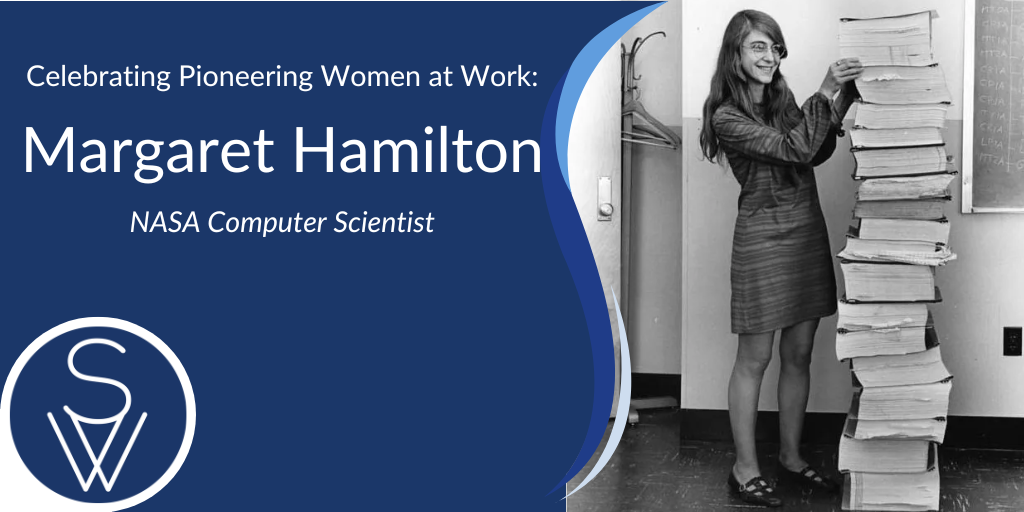
Part of our Women's History Month Series: Celebrating Pioneering Women at Work
This month, in celebration of Women's History Month, SkyWater Search Partners will highlight the achievements and legacies of Pioneering Women at Work. Here, we spotlight Margaret Hamilton, one of the most consequential yet under-appreciated figures in the history of space exploration. A Massachusetts Institute of Technology (MIT) scientist whose pioneering work in software engineering was central to the Apollo space program's success, Hamilton led the software team responsible for enabling Apollo 11 astronauts to land safely on the moon.
Help Wanted
By the early 1960s, Margaret Hamilton was already an accomplished MIT software developer, having created software for their meteorology division that predicted weather and software for the U.S. Air Force, among many other accomplishments. But despite her stellar credentials, the Apollo opportunity didn't present itself to her. A recruiter didn't approach her. She didn't get an introduction via a professional network.
She saw a newspaper ad for a job that would help "send man to the moon" and she was intrigued.
She got the job, becoming the Apollo project's first female programmer. It was a fact that several people in management worried that the men on the team would rebel. But they didn't. In fact, before long, Hamilton was leading the team that wrote and tested the Apollo on-board, in-flight software.
The Original Software Engineer
As startling as it seems today, back then, the very idea of "software" was still fairly new and misunderstood. The roles of "hardware engineers" were widely recognized and esteemed for their critical role in space travel. But very few grasped the essence or importance of software, much less the skill and ingenuity of those who developed it. Observing this disparity, Hamilton boldly decided to claim the engineer title for herself and her software peers, pointing out that software development was just as vital and skill-intensive as hardware development. At first, colleagues rejected the name. A few even belittled it. But Hamilton persisted. Today, thanks to Hamilton's perseverance, the software engineering discipline is recognized, without question, in the lexicon of technology and beyond.
She Brought her Daughter to Work
In an era when work-life balance concepts were practically nonexistent, especially in the high-pressure environment of space exploration, Margaret Hamilton often found herself grappling with gaps in her babysitting coverage. Her solution was both practical and bold for the time: she brought her young daughter to the lab with her. This unconventional choice led to an unexpected breakthrough. One day, as her daughter played with a simulator keyboard, she inadvertently crashed the simulator. This incident was a lightbulb moment for Hamilton, underscoring the potential for human error in space missions. She quickly realized that if a child could unintentionally cause such a problem, so could an astronaut, especially under the unique stresses of space travel.
But when Hamilton proposed an addition to the software to safeguard against this type of error, her management team declined to approve the addition, arguing that highly trained astronauts would never make such a mistake. However, the unexpected happened during the Apollo 8 moon orbit when an astronaut accidentally did precisely what Hamilton had feared. Thanks to Hamilton's foresight, she was able to react swiftly and, within hours, had devised a solution that brought the spacecraft and its astronauts home safely.
A Presidential Medal of Freedom Recipient
In recognition of her groundbreaking contributions to software engineering and space exploration, Margaret Hamilton was awarded the Presidential Medal of Freedom by President Barack Obama in November 2016. During the ceremony, President Obama highlighted her pivotal role, highlighting her leadership of the team that created "software architecture that was stable enough to handle the needs of processing astronauts' data and reliable enough to not misfire in the dangerous environment of space." Obama's remarks underscored not only Hamilton's technical mastery but also her unwavering commitment to mission success, cementing her legacy as a pioneer in her field. Hamilton, he said, "symbolizes that generation of unsung women who helped send humankind into space.”
Margaret Hamilton's contributions did much more than help mark a giant leap forward for "mankind." She paved the way for generations of female software engineers - and working mothers across many disciplines - by redefining the boundaries of what is possible in science, space exploration, and technology.






